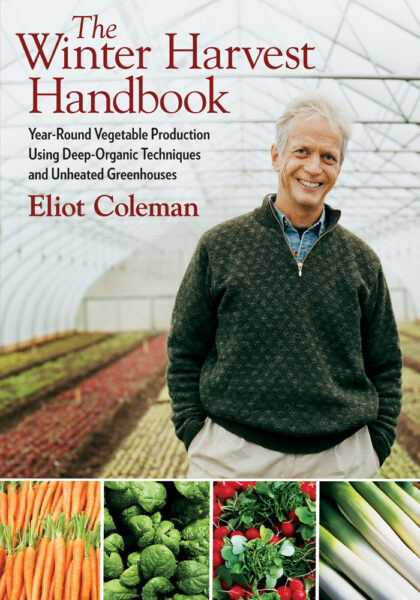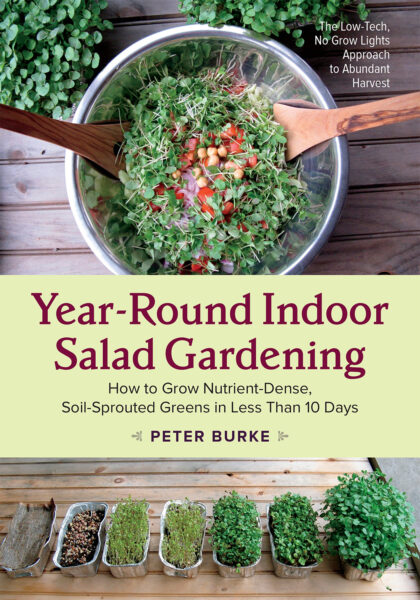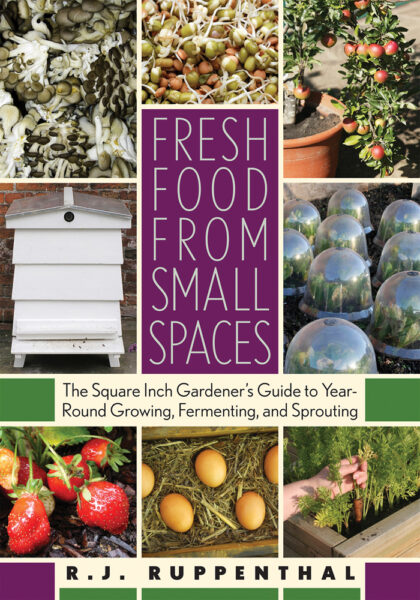Chickpea Sprout Hummus: Breathe Life Back Into Winter
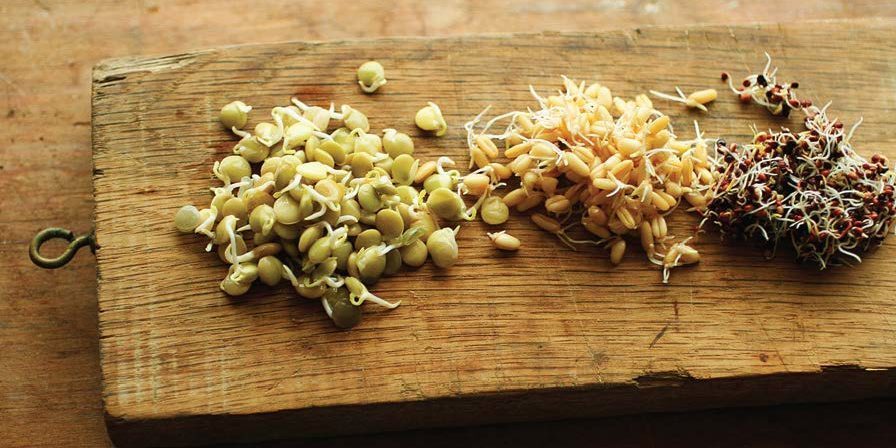
Just because the months are getting colder doesn’t mean you can’t still have homemade hummus with fresh chickpeas; you just have to get creative with it. This hummus recipe uses chickpea sprouts, which are growable indoors and during winter.
The following is an excerpt from Wild Flavors: One Chef’s Transformative Year Cooking from Eva’s Farm by Didi Emmons. It has been adapted for the Web.
RECIPE: Sprouted Hummus
I had survived another yoga session and was basking in Shivassana when the inspiration of sprouted chickpea hummus arrived into my head. I thought I had just invented a recipe, but I Googled it when I got home and realized it was a very unoriginal thought. Still, I went ahead with my own version. I like to eat the hummus with tart apple slices or fresh whole-grain (sprouted!) bread
Makes 1½ cups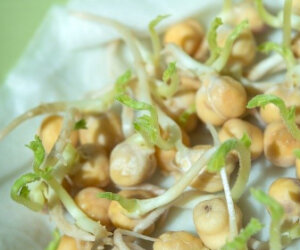
Ingredients
- 3 or 4 garlic cloves
- 1 cup chickpea sprouts
- 2 tablespoons lemon juice (about ½ lemon)
- ¼ cup tahini
- 1 teaspoon ground cumin
- ½ teaspoon salt
- ½ teaspoon freshly cracked black pepper
- 3 tablespoons extra-virgin olive oil
Procedure
- Toss the garlic in a food processor and run the machine until itis finely chopped. Add the chickpea sprouts and pulse until they are pureed. Add the lemon juice and 2 or 3 tablespoons water and puree again until the mixture is mostly smooth.
- Add the tahini, cumin, and salt and pepper. With the machine running, slowly add the olive oil. Taste for seasoning and serve
Growing sprouts is one of the simplest things you can do to breathe life into the deprivations of winter. As an urbanite who doesn’t have much space or sun to grow food, sprouts are one thing I can grow at any point in the year. Sprouts are replete with vitamins, minerals, proteins, and enzymes. Sprouting is easy, as easy a process as cooking rice. And there is a satisfaction in fostering and watching them grow and prosper. It feeds my maternal side, without the crying and diapers.
Most any edible seed can become an edible sprout, but I like to sprout wheat berries, kamut, quinoa, lentils, and chickpeas. Other possibilities include hulled sunflower seeds, buckwheat groats, spelt, soybeans, peas, brown mustard seeds, radish seeds, broccoli seeds, rye seeds, cabbage seeds, and herb seeds. You can also sprout raw peanuts, black-eyed peas, adzuki beans, green channa, and, more commonly, alfalfa, clover, and mung bean. Tomato and potato sprouts are said to be poisonous.
Growing Sprouts At Home
There are two main ways to grow sprouts at home: in a jar or in a bag (of any sturdy mesh fabric, whether natural or synthetic fiber).
- In either case, start by rinsing about 1 cup of legumes or seeds and then letting them soak overnight.
- Drain, rinse again, and transfer the legumes or seeds to a big glass jar or mesh bag large enough to hold five times the quantity of seeds or legumes that you have.
- Tie the bag closed or secure cheesecloth over the mouth of the jar to keep debris out and to facilitate easy straining. Hang the bag or store the jar in a dark, humid place if possible, and rinse morning and night.
- Eventually, after somewhere between two and ten days, depending on the type of seed, you will notice that the seeds have sprouted.
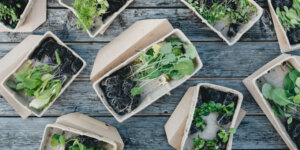 You may have noticed that there is a lot of rinsing involved here, and watching all of that barely used water head down the drain goes against every fiber in Eva’s body. When she rinses the seeds or legumes the first time, she catches that liquid in a bowl. To rinse the seeds or legumes afterward, she simply dips her bag into the captured water, lifts it up, and shakes the liquid out. Once the seeds or legumes have sprouted and the rinsing has ended, she uses the liquid for a variety of creative uses, from cooking her morning cereal to watering (and nourishing) plants.
You may have noticed that there is a lot of rinsing involved here, and watching all of that barely used water head down the drain goes against every fiber in Eva’s body. When she rinses the seeds or legumes the first time, she catches that liquid in a bowl. To rinse the seeds or legumes afterward, she simply dips her bag into the captured water, lifts it up, and shakes the liquid out. Once the seeds or legumes have sprouted and the rinsing has ended, she uses the liquid for a variety of creative uses, from cooking her morning cereal to watering (and nourishing) plants.
Sources
Don’t buy your seeds at a garden center, there is a risk they may be contaminated with chemicals or bacteria. I get my seeds at a local natural foods store and they sprout—no problem. But if you are serious, there are plenty of websites like Sproutman.com that sell seed grown specifically for human consumption. “The Sproutman” also offers a helpful circular sprout chart for $5 that lists an array of seeds you can sprout, with the corresponding sprouting times, the suggested method, the level of difficulty, uses, flavors, and so on. It is worth getting.
Storage
After giving sprouts one final rinse, put them back in the same container you grew them in or in a plastic bag poked with a knife to ensure air circulation. Sprouts are living plants. They last about a week in the fridge in a plastic container, though legume sprouts may last longer.
Recommended Reads
Recent Articles
Everyone loves a refreshing, fermented, nutritious drink…even your garden! Take your fermentation skills out of the kitchen and into the garden by brewing fermented plant juice. The following is an excerpt from The Regenerative Grower’s Guide to Garden Amendments by Nigel Palmer. It has been adapted for the web. How to Make Fermented Plant Juice Fermented…
Read MoreOh, honeysuckle…how we love thee. If only there was a way to capture the sweet essence of this plant so we could enjoy it more than just in passing. Luckily, foraging and some preparation can help make that happen! Here’s a springtime recipe that tastes exactly like honeysuckle smells. The following excerpt is from Forage,…
Read MoreWant to see your crops thrive this upcoming growing season? The key is in soil fertility and health. Spend time maintaining your soil’s health to guarantee bigger and better crops come harvest time! The following is an excerpt from No-Till Intensive Vegetable Culture by Bryan O’Hara. It has been adapted for the web. What Is Soil Fertility?…
Read MoreIntroducing…your new favorite brunch dish! This whole broccoli frittata is packed with fresh, wildcrafted flavors that are bound to help you start your day off on the right foot. The following is an excerpt from The Forager Chef’s Book of Flora by Alan Bergo. It has been adapted for the web. RECIPE: Whole Broccoli Frittata…
Read MoreMany know the effects of catnip on our feline friends, but few realize that catnip has medicinal effects for humans. From stomach aches to reducing fevers, catnip is a versatile herb with many benefits. The next time you grow this plant for your cat you may end up taking a few cuttings for yourself! The…
Read More

